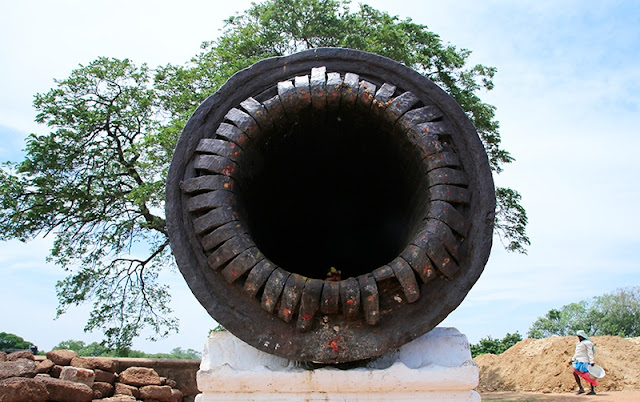Rajagopala Beerangi, Beerangi Medu, Thanjavur
Rajagopala
Beerangi is massive cannon in Beerangi Medu, Thanjavur which takes pride of
place at the eastern gate of the Fort here. This amazing cannon, which was cast
in 1620, speaks wonders of the metallurgical skills of the people of Thanjavur
during that time. Apparently, they enlisted Danish technical know-how to cast
the cannon. Cannon is a huge sized and qualitative display of workmanship at
the top of the East Kothalam.
Beerangi
Medu, where a 17th century forge-welded iron cannon is mounted at Keela Alankam
in Thanjavur town, a heritage monument, remains a place of neglect. Liquor
bottles, plastic packets and eatables strewn around the cannon at the heritage
site indicate the sorry state of affairs.
Interestingly,
it is a monument protected by the Archaeological Survey of India (ASI). A board
put up at the entrance of the fleet of steps leading to the mounted cannon at
the site says: “This monument has been declared to be of National Importance under
the Ancient Monuments and Archaeological sites and Remains Act 1958.
As per the
Ancient Monuments and Remains (Amendment and Validation) Act 2010, whoever
destroys, removes, injures, alters, defaces or misuses this monument, shall be
punishable with imprisonment up to two years or with fine up to Rs one lakh or
with both”. Walls of the site are defaced and names engraved on them.
History
The
cannon is said to be one of the biggest in the world. It is of amazing size and
speaks volumes of the metallurgical skill of the people in 17th century. The
cannon have been made using Danish technical skills. It was mounted in 1620
when Ragunatha Nayak was the King of Thanjavur (1600-1645 A.D.).
Rajagopalabeerangi
(Rajagopala Beerangi) was used in 1650 during the Nayak period to protect
Thanjavur form enemies who entered through Keelavasal (eastern gate). This huge
cannon was cast at Kollumedu near Thanjavur and erected in 1620.
The
Cannon
Rajagopalabeerangi
is considered the largest cannon in India so it is worth a Visit.
Interestingly, even after all these centuries, the cannon have not rusted. The
26-foot-long cannon weigh 22 tonnes. It is forge-welded and has not been made
by casting. The nearly 400-year-old cannon, though exposed to sun and rain, have
not rusted. The outer circle is 300 mm in diameter, while the inner circle is
150 mm in diameter. Inside, it is made using 43 long iron plates and the outer
of 94 iron rings. To lift the cannon eight rings were present on top. But now,
only two rings are found. It was used to protect Thanjavur from enemies who
used to enter through ‘Keelavasal' (eastern gate).
It can
fire a cannon ball (iron) of 1000 Kg weight. No wonder it finds fourth place in
the list of Largest Cannons fired in the World History. This Cannon was named
"Rajagopala Beerangi (Cannon), but popularly known as "Daasimettu
Beerangi" is placed on an elevated (25'high) defense barricade at the
eastern Rampart of the Thanjavur Fort.
Surprisingly many people living in Thanjavur
may not be aware of the existence of such a huge Cannon in Thanjavur.
Interestingly though many locals may not be aware of such thing of heritage
value is there in their Town, this Cannon finds a place in the list of Largest
Cannons in World History.
Unfortunately,
encroachments around the site – pucca built houses (which are not allowed
around an archaeological site), – cattle rearing by people in the vicinity,
wild growth of weeds rob the cannon site of all beauty. From the site (top) one
can see the Sarjah Madi (seven-floor structure) and the Arsenal tower of Nayak
Palace on the western side.
However,
the Thanjavur chapter of the Indian National Trust for Arts and Cultural
Heritage (INTACH) has taken steps to protect and popularize the site and to
maintain it well. It organized heritage walk to the site and celebrated India
Tourism day recently with foreign tourists. But after these events, the place
remains neglected.











